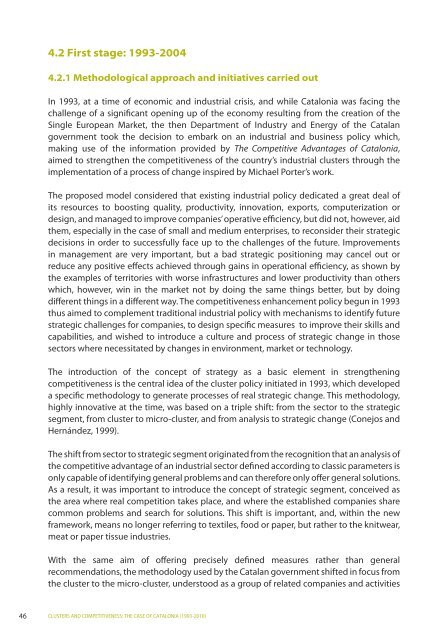Clusters and competitiveness - PRO INNO Europe
Clusters and competitiveness - PRO INNO Europe
Clusters and competitiveness - PRO INNO Europe
You also want an ePaper? Increase the reach of your titles
YUMPU automatically turns print PDFs into web optimized ePapers that Google loves.
4.2 First stage: 1993-2004<br />
4.2.1 Methodological approach <strong>and</strong> initiatives carried out<br />
In 1993, at a time of economic <strong>and</strong> industrial crisis, <strong>and</strong> while Catalonia was facing the<br />
challenge of a significant opening up of the economy resulting from the creation of the<br />
Single <strong>Europe</strong>an Market, the then Department of Industry <strong>and</strong> Energy of the Catalan<br />
government took the decision to embark on an industrial <strong>and</strong> business policy which,<br />
making use of the information provided by The Competitive Advantages of Catalonia,<br />
aimed to strengthen the <strong>competitiveness</strong> of the country’s industrial clusters through the<br />
implementation of a process of change inspired by Michael Porter’s work.<br />
The proposed model considered that existing industrial policy dedicated a great deal of<br />
its resources to boosting quality, productivity, innovation, exports, computerization or<br />
design, <strong>and</strong> managed to improve companies’operative efficiency, but did not, however, aid<br />
them, especially in the case of small <strong>and</strong> medium enterprises, to reconsider their strategic<br />
decisions in order to successfully face up to the challenges of the future. Improvements<br />
in management are very important, but a bad strategic positioning may cancel out or<br />
reduce any positive effects achieved through gains in operational efficiency, as shown by<br />
the examples of territories with worse infrastructures <strong>and</strong> lower productivity than others<br />
which, however, win in the market not by doing the same things better, but by doing<br />
different things in a different way. The <strong>competitiveness</strong> enhancement policy begun in 1993<br />
thus aimed to complement traditional industrial policy with mechanisms to identify future<br />
strategic challenges for companies, to design specific measures to improve their skills <strong>and</strong><br />
capabilities, <strong>and</strong> wished to introduce a culture <strong>and</strong> process of strategic change in those<br />
sectors where necessitated by changes in environment, market or technology.<br />
The introduction of the concept of strategy as a basic element in strengthening<br />
<strong>competitiveness</strong> is the central idea of the cluster policy initiated in 1993, which developed<br />
a specific methodology to generate processes of real strategic change. This methodology,<br />
highly innovative at the time, was based on a triple shift: from the sector to the strategic<br />
segment, from cluster to micro-cluster, <strong>and</strong> from analysis to strategic change (Conejos <strong>and</strong><br />
Hernández, 1999).<br />
The shift from sector to strategic segment originated from the recognition that an analysis of<br />
the competitive advantage of an industrial sector defined according to classic parameters is<br />
only capable of identifying general problems <strong>and</strong> can therefore only offer general solutions.<br />
As a result, it was important to introduce the concept of strategic segment, conceived as<br />
the area where real competition takes place, <strong>and</strong> where the established companies share<br />
common problems <strong>and</strong> search for solutions. This shift is important, <strong>and</strong>, within the new<br />
framework, means no longer referring to textiles, food or paper, but rather to the knitwear,<br />
meat or paper tissue industries.<br />
With the same aim of offering precisely defined measures rather than general<br />
recommendations, the methodology used by the Catalan government shifted in focus from<br />
the cluster to the micro-cluster, understood as a group of related companies <strong>and</strong> activities<br />
46 CLUSTERS AND COMPETITIVENESS: THE CASE OF CATALONIA (1993-2010)
















